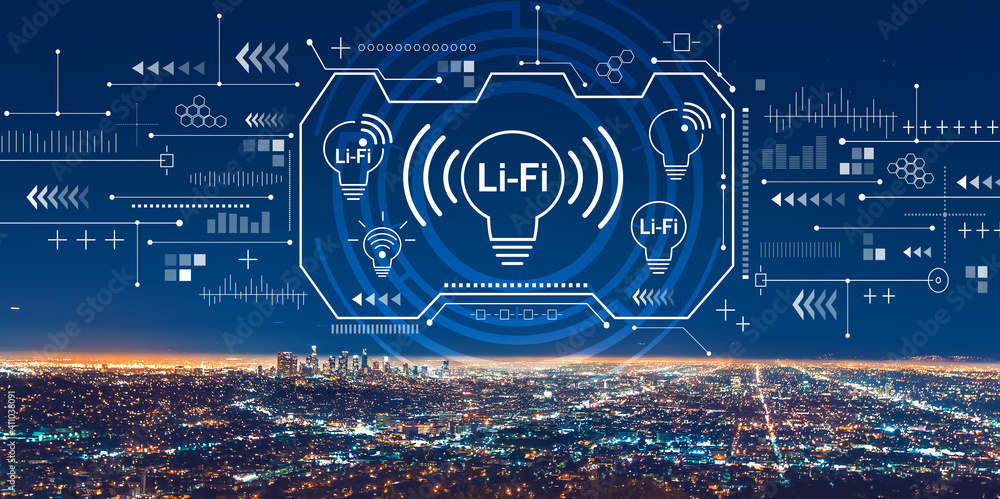The global Li-Fi market is emerging as a transformative force in the world of wireless communication. Li-Fi, or Light Fidelity, is a wireless communication technology that uses visible light to transmit data. Unlike traditional Wi-Fi that uses radio frequencies, Li-Fi transmits data through light-emitting diodes (LEDs) at extremely high speeds.

This innovative technology is gaining significant traction due to its ability to offer faster, more secure, and interference-free data transmission. With rising data consumption and increasing demands for bandwidth, the Li-Fi market is poised for substantial growth in the coming years.
Understanding Li-Fi Technology
Li-Fi operates by modulating the intensity of LED light to transmit data. These modulations are so rapid that they are imperceptible to the human eye. A photodetector at the receiving end converts the light signal back into data, creating a high-speed and reliable communication channel.
Key characteristics that differentiate Li-Fi from Wi-Fi include:
-
Use of the visible light spectrum
-
Immunity to electromagnetic interference
-
Enhanced data security
-
Reduced latency and ultra-fast transmission speeds
Market Overview
The Li-Fi market is still in its early stages but is experiencing rapid development due to increasing investments in R&D and pilot deployments across various sectors. North America and Europe are leading in terms of adoption, primarily due to a strong presence of technology developers, government support for smart infrastructure, and early interest from defense and healthcare sectors.
The Asia-Pacific region is also expected to witness rapid growth owing to rising industrial digitization, increasing smartphone penetration, and large-scale deployment of LED lighting infrastructure.
Drivers of Li-Fi Market Growth
1. Need for High-Speed Data Transfer
As consumers and businesses demand faster connectivity for activities such as 4K video streaming, virtual meetings, and cloud computing, Li-Fi offers an alternative to congested radio frequency spectrums by leveraging the underutilized visible light spectrum.
2. Increasing Demand for Secure Communication
Because light cannot pass through walls, Li-Fi is inherently more secure than Wi-Fi. This makes it highly desirable in environments such as military installations, financial institutions, and government offices.
3. Rising Adoption of Smart and IoT Devices
The proliferation of smart home systems, connected vehicles, and industrial IoT is placing unprecedented pressure on existing wireless networks. Li-Fi can help offload data traffic and enhance network efficiency in these applications.
4. Integration with Existing LED Infrastructure
Since Li-Fi can function using standard LED lighting systems, its deployment can be cost-effective, especially in indoor environments like hospitals, schools, malls, and offices.
Applications of Li-Fi Technology
The Li-Fi market is expanding across various sectors:
-
Healthcare: Provides secure and interference-free data transfer, especially beneficial in environments where radio waves can disrupt medical instruments.
-
Defense and Security: Offers high data security due to confined signal reach, making it ideal for secure data communication.
-
Industrial Automation: Enables real-time control and communication in factory floors without electromagnetic interference.
-
Education: Facilitates fast and secure access to digital content in classrooms without increasing Wi-Fi traffic.
-
Retail and Malls: Can be used for indoor navigation, targeted advertisements, and real-time analytics.
Market Challenges
Despite its potential, the Li-Fi market faces several challenges:
-
Limited Range and Line-of-Sight Requirement: Light-based communication requires a clear line of sight, making it less flexible in certain environments.
-
Lack of Standardization: The absence of global standards hinders interoperability and mass adoption.
-
High Initial Deployment Costs: Upgrading existing infrastructure to be compatible with Li-Fi systems may involve substantial investment.
-
Technological Complexity: Building systems that maintain high data rates in dynamic environments is a challenge for developers.
Key Players in the Market
Several companies are pioneering developments in the Li-Fi market, including:
-
pureLiFi
-
Oledcomm
-
Signify (Philips Lighting)
-
VLNComm
-
Lucibel
-
LumEfficient
-
Firefly LiFi
-
LightBee Corp
-
FSOna Networks
-
Panasonic Corporation
These players are actively involved in product innovation, partnerships, and pilot projects aimed at testing and deploying Li-Fi technology in real-world environments.
Future Outlook
The future of the Li-Fi market looks promising as the technology continues to mature. With increasing awareness, technological refinements, and regulatory support, Li-Fi is expected to complement existing communication technologies and find widespread application in smart cities, autonomous vehicles, and smart buildings.
Hybrid systems integrating both Wi-Fi and Li-Fi could become the norm, leveraging the strengths of both technologies for a more resilient and high-capacity wireless ecosystem.
In conclusion, the Li-Fi market is lighting the path toward the next era of high-speed, secure, and efficient wireless communication. As the world embraces digital transformation, Li-Fi is well-positioned to play a pivotal role in shaping the future of connectivity.